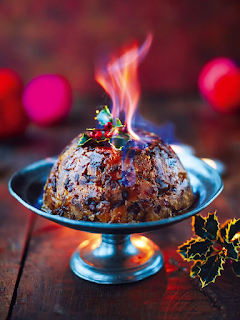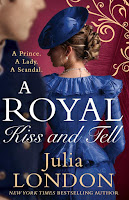
She's discovered his secret.
Now the trouble really begins...
After three years of mourning—and turning her dear deceased husband's
gazette into the ton's sauciest source of fashion and gossip—Hollis
Honeycutt feels her life has been strangely bereft of late... Her sister
is living abroad, and her best friend moved to the country. What must a
young widow of rank and reputation do? Why, transform her society
gossip sheets into serious investigative news, starting with a rumored
coup...and the rather dashing, mysterious gentleman whom Hollis suspects
might be the villain of her first real story, and she is the only one
who can write it.
Marek Brendan is investigating terrible rumors of treachery and treason
that threaten his home country of Wesloria, but he must proceed with
caution. No one can discover the truth. After all, who would ever
believe he is Wesloria's lost crown prince? Only Hollis Honeycutt's
cerulean-blue eyes seem to know more than she's letting on—and worse,
Marek can't seem to resist her curious charms. But even as betrayal
threatens a nation and a throne, nothing is quite so dangerous as the
lovely young widow who's determined to find the truth...and a prince of
her own.

Title: A Princess by Christmas
Author: Julia London
Series: Royal Wedding Series - Book 3
Pages: 384
Genre(s): Historical, Victorian, England, Royalty
Hot Buttons: n/a

Christmas Tree
Many of Britain’s Christmas traditions were popularised by Queen Victoria through her husband, Prince Albert. Albert was brought up in Germany where, during the Christmas festivities, it was popular to bring in a tree to the home, decorating it with candles, fruits and sweets. He brought the tradition to Britain where it quickly became the fashion.
In 1848 the Illustrated London News published a drawing of the royal family celebrating around a Christmas tree filled with candles, ornaments and with an angel on top.
“I was saying that Prince Albert brought the tradition of a Christmas tree to London, and none of us have been the same since! I told Donovan we must bring a tree and trim it with all the proper things, and he asked me what the proper things are, and really, I don’t know. Bows, I should think.”

Christmas Carols
Although Christmas carols, or Christmas hymns, can be traced as far back as the 4th century, many of our more well-known carols were either written or popularised in the 19th century. This was, in part, to do with the publication of Christmas music books - sheet music that people would buy to play the most up to date music at home. Similarly, the Victorian era saw the first time that Christmas carols were sung in churches, further popularising the festive tunes. It has been suggested that this might be the reason that people went to the streets to sing carols - since they couldn’t do so in church.
A gift of la fée verte from the Marquess of Douglas and three sprigs of mistletoe from Lady Chartier made the evening much more festive than anyone might have anticipated. Neighbours reported that carollers threw open the windows and the sound of their voices could be heard blocks away. Three hackneys were called the following morning to cart some of the most ardent revellers away.
- Honeycutt’s Gazette of Fashion and Domesticity for Ladies

Kissing Under the Mistletoe
Mistletoe, in many cultures and religions, has magical properties, offering protection from witches, demons, spirits while also being regarded as a symbol of fertility.
The Romans also associated mistletoe with peace and love, hanging it over their doorways both to bring good favour to the household and also offer protection. They also used mistletoe in the festival of Saturnalia, from which many Christmas traditions take their roots.
Mistletoe would also be included in kissing boughs - a globe of greenery popular in England from the middle ages. Visitors would embrace their hosts under the bough, showing they only brought goodwill with them during their visit. Similar ‘kissing balls’ of evergreen and mistletoe were popular in the Victorian era.
Kissing under the mistletoe was immortalised in Dickens’ A Christmas Carol in 1843. It is thought that the serving class in Victorian England helped to really cement this tradition in our traditions.
She glanced up, to the mistletoe hanging over their heads. Marek looked up, too. Before he could discern what she was thinking, Hollis caught his lapels and pulled him forward as she rose up on her toes. “Happy Christmas,” she said, and she kissed him.
The origins of plum pudding are just as unclear as many other Christmas traditions we still hold dear. What’s clear is that plum pudding was definitely being eaten well before the Victorian period, even being served at William IV’s birthday feast.
In 1861, Mrs Beeton included a recipe for Christmas Plum Pudding in her popular cookbook but its popularity was cemented due to Queen Victoria and Prince Albert’s inclusion of the pudding in their own Christmas day festivities.
Ruth came to help her dress, and she put on the best gown of those that fit. “I shouldn’t have had a second helping of the plum pudding,” she complained as Ruth helped stuff her into a gown.
Mince Pies

The original mincemeat pie was likely invented in the 13th century. Mincing meat with spices, suet and fruits was an alternative preserving method to salting or smoking.
With the inclusion of meat, mince pies started off as a main course dish. It wasn’t until the late 19th century that the inclusion of meat fell out of fashion, and the pies became smaller, rounder and turned into the sweet treat we know today.
They haven’t lost their appeal since Victorian times, either. In
2019, the UK would eat approximately 781,177,935 mince pies during the
Christmas season.
They all made their way across the hall to the dining room, then squeezed around the table. Margaret had gone to a lot of trouble. The goose was cooked to a golden-brown. She’d prepared oysters and Yorkshire pudding and, she said proudly, “A sweet mince pie.”

Buy this book:
The Royal Wedding Series:























































